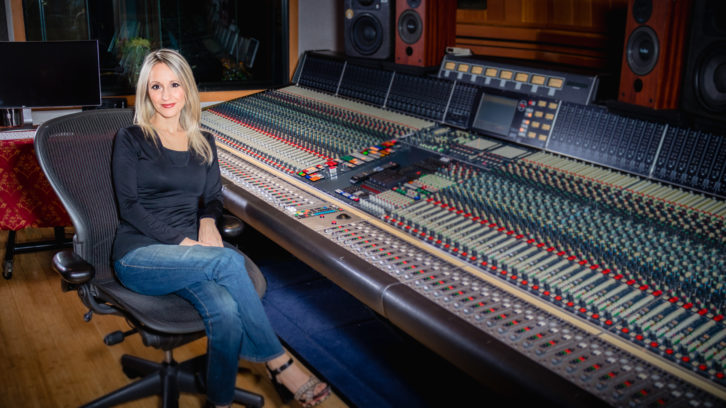
The recent “I’m Standing With You” project had all the markings of a hot mess, with plans for as many as 170 artists turning in individual performances on cell phones from their noisy homes with no hard synchronization. But when you have a determined music director/arranger like Sharon Farber, a visionary film director like Gev Miron and expert mixer like Michael Stern, potential for disaster can turn into the exquisite.
A few months ago, Farber and Miron had an idea to put together a small lockdown rendition of Diane Warren’s Academy Award–nominated song “I’m Standing With You” to raise money for the United Nations Foundation’s COVID-19 Solidarity Response Fund for the World Health Organization. Warren was all in.
“When I wrote the song for the movie Breakthrough, I always thought it would live outside of that movie. I loved the movie, but I always thought that the song was bigger,” Warren says, noting that it has been used for other such events as the ACLU, 50th anniversary of Stonewall Forever, and the Academy of Country Music women’s voices.
Warren had no compunction about Farber changing the arrangement of the song, from the very first moment where cellist Tina Guo plays a four-bar phrase heard throughout as a motif, by various instruments and vocals.
“I was like, ‘Do whatever you want, the song exists in its form,’ and I think what she did as far as arrangement and production is quite brilliant,” Warren says.
Initially the idea was to access the local musical community, but Warren, Farber and Miron decided that the idea should represent the global experience. Once they opened up that landscape, the outpouring of phone calls from those wishing to participate brought together—virtually—musical artists spanning six continents and 11 nations. As it snowballed, the arrangement grew. And it grew to embrace not just multiple cultures, but a myriad of musical genres including pop, classical, world and gospel, to “give the message of one world,” Farber says.
Miron did not want to use Zoom. Not for the material he would be editing, as he wanted to communicate the isolation of the separateness of the times, along with the images of the abandoned city streets. A Zoom Gallery view would defeat that. They also rejected the popular Zoom platform because they wanted to place the orchestra musicians in their proper positions.
Warren was pleased about the choice: “I was really blown away when I saw it,” she says. “I thought it was going to be like a lot of the other videos that look like the Brady Bunch with little squares with faces popping up on the screen, but it was super powerful; a stunning work of art.”
Liyah Bey Lapidot sang the provided guide vocal (as well as a featured spot), which Farber had generated in Digital Performer for all the featured singers—each participant was to perform the song in its entirety and improvise at the end, so that Farber could create duets, trios and other groups within the arrangement.
A Multitude of Videos

When the contributions came in, mixer Stern received a grand total of 173 instrumental and choral parts. Stern and Miron’s job was to sync all the musicians separately, the audio in Pro Tools, and the video using Adobe Premiere and to work on the video while Farber was in charge of working on the 19 featured vocal parts. Not everyone ended up singing the whole piece, but Farber says she was able to edit in a way that made sense for the project, featuring everybody and creating a powerful presentation.
“It was an interesting process because everyone has a different style,” Farber says. “How do you do it so it sounds like one unit? Everybody sang the chorus, but everyone has different phrasing, so I had to cut and paste and cut and paste, fade in and fade out, in order to cut things that didn’t work together and move it so it looks the same. It was a nightmare, but a creative and satisfying one!
As daunting as the project was, everyone had faith that Stern could pull it all together. “If this were a real concert in a huge hall, there would be reverb and the sound of the hall and that’s why we have great engineers who can make this happen,” Farber notes. [Warren adds: “How the f— did he do it?”]
Stern didn’t use the word “nightmare,” but certainly the word “challenge” proved an understatement.
“In the cellphone recordings, there were a lot of barking dogs,” Stern notes. “A lot of mismatched ambiences, of course, some of them had a huge amount of clicks and pops. There was one cello track that had a thunderstorm raging that was equally as loud as the cello.”
As performances were collected, Stern received them via Dropbox and says he had to strip the audio out from the video using Quicktime. Anything not shot on an Apple product was not compatible, so Miron extracted those.
“There was a zero bar with a count-off and they would clap or snap their fingers at bar one, and then I would still have to line them up,” says Stern, who used the latest version of Pro Tools Ultimate 2020 at his 5.1 studio, The Mix Lab, which is in a solar-powered building in Chatsworth, Calif. “Every single track needed to be massaged in terms of playing in time and in tune,” he adds, explaining that even those in the best shape might take 45 minutes to an hour and a half to make sound like an ensemble, as no one played together in the same room. With so many musicians performing alone, there had to be an extensive amount of Auto-tune usage.
Once Stern put everything into Pro Tools, it became very clear it would be in need of a significant amount of audio forensics, cleanup and restoration, so he called up iZotope in Boston. “iZotope were incredibly responsive and helpful,” he acknowledges. “They provided me with their RX7 Advanced Suite.” While restoration and cleanup is not something typically used in Stern’s work as a music scoring mixer, the majority of the film and TV projects in his background, they were essential in preparation for this project, which ended up at 255 tracks.
Stern mixed pretty much entirely in the box, and his monitoring setup included Bryston 9BSST 5.0 Surround Power Amplifiers, a Bryston 4B amp to power Ultrasone PRO 650 headphones, and Dynaudio Acoustics BM15 Passive Monitors with a Dynaudio Acoustics BM14S Active Subwoofer through an SPL Surround Monitor Controller Model 2489. He made use of Altiverb, as well as his Lexicon PCM 96 Digital Reverb externally for the orchestra, and the TC Electronic M5000 Digital Reverb for the choir on the Gold-Plate setting. He used Eventide compressors and reverbs extensively, as well, and the Waves Eddie Kramer Master Tape Emulation (“because it can often take the edge off and warm up instruments that are close-miked and kind of abrasive.”). He also made use of Graphic Auto-tune and AudioSuite Auto-tune.
“It’s rare that I use AudioSuite Auto-tune. I vastly prefer the control of graphic Auto-tune but because of the size, scope and volume of this, I used each as needed,” Stern says.

With an overwhelming amount of instrumentalists, including the 73-piece Texas Medical Center Orchestra (many of whom are medical professionals, representing those on the front lines), Los Angeles orchestral session players, the Spirit of David Gospel Singers, a Los Angeles–based choir, Farber on piano and Stern on guitar, Tony Levin on bass and Tal Bergman on drums, as well as 19 featured singers, including such stars as Renée Fleming (U.S.), Soprano Sumi Jo (South Korea), The Voice’s Chris Mann (U.S.), Tina Arena (Australia), Mario Frangoulis (Greece), Federico Paciotti (Italy), Russell Watson, and nine-year-old show-stealer Eden Kontesz-Farber (Sharon’s daughter)—well, a bit of distortion was inevitable.
Stern says his clarion moment came about two weeks into the project when he realized that using lowpass filtering on all of the cell phone recordings and setting the filters anywhere from 3 to 7 kiloHertz, depending on the track, was a game changer. For the filtering Stern used the Waves V-EQ4.
“It was a night and day moment for me,” Stern says. “With so many elements at the end of the song all going at once, it sounded like a haze of distortion. The upper midrange and highs on cell phone recordings are so very harsh, and with so many tracks, were adding up unbearably. When I applied the filters, that was the moment I thought, ‘This is going to be okay,’ It was a formidable undertaking.”
Just the Music, Please

The project took about two months from beginning to end, especially for Farber, who wrote the arrangement, then re-arranged it, then brought all the musicians together and worked on the lead vocals while producing the project with Miron and Warren. The song debuted on the UN’s YouTube Channel May 22, 2020. The first Digital Performer file was delivered to Stern April 15 and mixing in Pro Tools was completed May 9, 2020. Stern completed the mix in just under a month as elements came in over a few weeks and were conformed to the phrasing and tuning.
On another note, Stern was not provided the video until they were close to the end of the project.
“As a mixer, you think of things musically first,” Stern says. “I’m a musician first. So when the picture came, some of the singers weren’t loud enough for their moment, so that required an adjustment both technically and emotionally, as I was so close to the mix at that point. But after I saw it to the final picture, it made perfect sense”
Farber came to his studio—maintaining social distance and both wearing masks—and they worked collaboratively to make the final adjustments. Then, Stern says, he handed it off to Patricia Sullivan at Bernie Grundman Mastering in Hollywood, CA and she did a “beautiful job” mastering it.
All worked on a voluntary basis, which so far has raised ($6 million) millions for organizations working in pandemic relief.
Stern asserts that everyone’s hard work paid off: “I do believe the end result sounds like they’re all playing in the same room at the same time. So many people wanted this to be beautiful and great. I was thrilled to play guitar on it, as well as engineer it, and particularly play on it with (bassist) Tony Levin in my headphones was a thrill. It makes me deeply appreciative of the talent pool and the willingness of creatives to give.”
Farber says she felt goosebumps watching it for the first time in its final form with her family. “It was so beautiful.”
Warren sums up the complexity of such an undertaking with cell phones during a quarantine with a profound statement: “You can’t stop music.”







